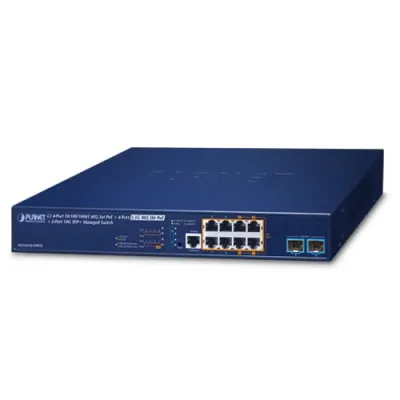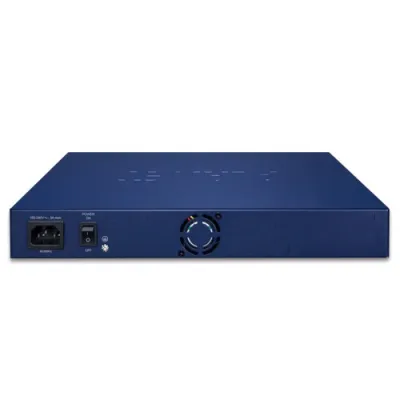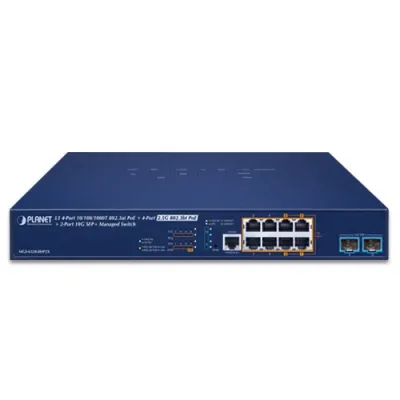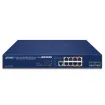Perfect Managed Multigigabit PoE Switch with L3/L2 Switching and Security
PLANET MGS-6320-8HP2X is a brand-new Layer 3 managed multigigabit switch providing 2.5Gbps data rate and 802.3bt PoE++ over UTP cables, designed for the demand of high-bandwidth required network equipment, such as Wi-Fi 6 802.11ax wireless AP, NAS, workstation and those with 2.5GBASE-T interfaces. It features 4 10/100/1000BASE-T copper ports with 802.3at PoE+ injector function, 4 100/1000/2500BASE-T copper ports with 802.3bt PoE++ injector function, a total PoE power budget of up to 240 watts and 2 extra 1G/2.5G/10GBASE-X SFP+ fiber ports that are flexibly designed to extend the connection distance. With such a favorable data link capability, hardware-based Layer 3 routing performance, Layer 2 and Layer 4 switching engine and user-friendly yet advanced IPv6/IPv4 management interfaces, it helps to accelerate the deployment of the next-generation IoT and wireless network for enterprises and smart cities.
2.5Gbps Capability for Diversified Bandwidth Applications
With the terminal access rates of 802.11ac wireless APs reaching as high as 1.2Gbps to 2.6Gbps, Gigabit ports have been unable to satisfy the demand. Supporting both 1Gbps and 2.5Gbps capability and 802.3af/at and 802.3bt PoE output, the MGS-6320-8HP2X can deliver not only data to 802.11ac wireless APs, but also power with the existing CAT5e Ethernet cables to other powered devices such as APs and IP cameras. It can definitely give you the speed you demand and its Plug and Play makes installation easy.
Redundant Ring, Fast Recovery for Critical Network Applications
The MGS-6320-8HP2X supports redundant ring technology and features strong, rapid self-recovery capability to prevent interruptions and external intrusions. It incorporates advanced ITU-T G.8032 ERPS (Ethernet Ring Protection Switching) technology and Spanning Tree Protocol (802.1w RSTP) into customer’s network to enhance system reliability and uptime in harsh environments. In a certain simple Ring network, the recovery time could be less than 10ms to quickly bring the network back to normal operation.
Cybersecurity Network Solution to Minimize Security Risks
The cybersecurity feature included to protect the switch management in a mission-critical network virtually needs no effort and cost to install. Both SSHv2 and TLSv1.2 protocols are utilized to provide strong protection against advanced threats. The network administrator can now construct highly-secure corporate networks with considerably less time and effort than before.
PLANET Network Management System (NMS) Solution
The MGS-6320-8HP2X supports PLANET’s NMS via CloudViewer App which is an Intelligent App to monitor your network from the cloud. With a cloud network, it makes data and services available from anywhere with an Internet connection. With PLANET CloudViewer, your network status can be monitored in real time anytime, anywhere via your mobile phone or tablet. User can easily check network status, device information, and port and PoE statuses from the cloud to reduce management costs.
Flexible and Extendable 10Gb Ethernet Solution
10G Ethernet is a big leap in the evolution of Ethernet. Each of the 10G SFP+ slots in the MGS-6320-8HP2X supports triple speed and 10GBASE-SR/LR or 2500BASE-X and 1000BASE-SX/LX. With its 2-port,10G Ethernet link capability, the administrator now can flexibly choose the suitable SFP/SFP+ transceiver according to the transmission distance or the transmission speed required to extend the network efficiently. The MGS-6320-8HP2X provides broad bandwidth and powerful processing capacity.
Built-in Unique PoE Functions for Surveillance Management
As a managed PoE Switch for variety networks, the MGS-6320-8HP2X features the following intelligent PoE management functions: PD Alive Check
- Scheduled Power Recycling
- SMTP/SNMP Trap Event Alert
- PoE Schedule
- PoE Usage Monitoring
- PoE Extension
Intelligent Powered Device Alive Check
The MGS-6320-8HP2X can be configured to monitor a connected PD status in real time via ping action. Once the PD stops working and it is without response, the MGS-6320-8HP2X will resume the PoE port power and bring the PD back to work. It will greatly enhance the network reliability through the PoE port resetting the PD’s power source, thus reducing administrator management burden.
Scheduled Power Recycling
The MGS-6320-8HP2X allows each of the connected PDs to reboot at a specified time each week. Therefore, it will reduce the chance of PD crash resulting from buffer overflow.
PoE Schedule for Energy Savings
Besides being used for IP surveillance, the MGS-6320-8HP2X is certainly applicable to build any PoE network including VoIP and wireless LAN. Under the trend of energy saving worldwide and contributing to the environmental protection on the Earth, the MGS-6320-8HP2X can effectively control the power supply besides its capability of giving high watts power. The “PoE schedule” function helps you to enable or disable PoE power feeding for each PoE port during specified time intervals and it is a powerful function to help SMBs and enterprises save energy and budget.
SMTP/SNMP Trap Event Alert
Though most NVR or camera management software offers SMTP email alert function, the MGS-6320-8HP2X further provides event alert function to help to diagnose the abnormal device owing to whether or not there is a break of the network connection, loss of PoE power or the rebooting response by the PD Alive Check process.
Convenient and Smart ONVIF Devices with Detection Feature
PLANET has newly developed an awesome feature ONVIF Support which is specifically designed for cooperating with video IP surveillances. From the MGS-6320-8HP2XGUI, you just need one click to search and show all of the ONVIF devices via network application. In addition, you can upload floor images to the switch and remotely monitor what is going on in the production line. Moreover, you can get real-time surveillance’s information and online/offline status, and can have PoE reboot control from GUI.
Solution for IPv6 Networking
With the support for IPv6/IPv4 protocol, and easy and friendly management interfaces, the MGS-6320-8HP2X is the best choice for IP surveillance, VoIP and wireless service providers to connect with the IPv6 network. It also helps SMBs to step in the IPv6 era with the lowest investment and without having to replace the network facilities even though ISPs establish the IPv6 edge network.
Layer 3 Routing Support
The MGS-6320-8HP2X enables the administrator to conveniently boost network efficiency by configuring Layer 3 IPv4/IPv6 VLAN static routing manually, the RIP(Routing Information Protocol) or OSPF(Open Shortest Path First) settings automatically. The RIP can employ the hop count as a routing metric and prevent routing loops by implementing a limit on the number of hops allowed in a path from the source to a destination. The OSPF is an interior dynamic routing protocol for autonomous system based on link state. The protocol creates a database for link state by exchanging link states among Layer3 switches, and then uses the Shortest Path First algorithm to generate a route table based on that database.
Robust Layer 2 Features
The MGS-6320-8HP2X can be programmed for advanced switch management function, such as dynamic port link aggregation, Q-in-Q VLAN, Multiple Spanning Tree Protocol (MSTP), Layer2/4 QoS, bandwidth control and IGMP/MLD snooping. The MGS-6320-8HP2X allows the operation of a high-speed trunk combining multiple ports. Supporting 4 trunk groups, it enables a maximum of up to 10 ports per trunk and supports connection fail-over as well.
Powerful Network Security
The MGS-6320-8HP2X offers comprehensive layer2 to layer4 access control list (ACL) for enforcing security to the edge. It can be used to restrict network access by denying packets based on source and destination IP address, TCP/UDP port number or defined typical network applications. Its protection mechanism also comprises 802.1x Port-based and MAC-based user and device authentication. With the private VLAN function, communication between edge ports can be prevented to ensure user privacy.
Advanced IP Network Protection
The MGS-6320-8HP2X also provides DHCP Snooping, IP Source Guard and Dynamic ARP Inspection functions to prevent IP snooping from attack and discard ARP packets with invalid MAC address. The network administrator can now build highly-secure corporate networks with considerably less time and effort than before.
Efficient Management
For efficient management, the MGS-6320-8HP2X is equipped with console, Web and SNMP management interfaces.
- With the built-in Web-based management interface, it offers an easy-to-use, platform-independent management and configuration facility.
- For text-based management, it can be accessed via Telnet and the console port.
- For standard-based monitor and management software, it offers SNMPv3 connection which encrypts the packet content at each session for secure remote management.
Intelligent SFP Diagnosis Mechanism
The MGS-6320-8HP2X supports SFP-DDM (Digital Diagnostic Monitor) function that greatly helps network administrator to easily monitor real-time parameters of the SFP and SFP+ transceivers, such as optical output power, optical input power, temperature, laser bias current, and transceiver supply voltage.
Features:
- Ports: 4 10/100/1000TX + 4 10/100/1000/2500TX + 2 1G/2.5G/10G X SFP
- Type: Managed
- PoE Ports: 8
- Standards:802.3at, 802.3bt
- Total PoE Budget: 240W (25°C), 200W (50°C)
- Max. Power Consumption: 281.6W/960.35BTU (Full Loading w/ PoE+)
- Throughput: 50.59Mpps/64Bytes
- Operating Temperature: 0 to 50°C
- Supports: Cloudviewer App (more info. below)
- TAA Compliant
| Hardware Specifications | |
| Copper Ports | 4x 10/100/1000BASE-T RJ45 auto-MDI/MDI-X interface with Port-1 to Port-4 |
| 4x 10/100/1000/2500BASE-T RJ45 auto-MDI/MDI-X interface with Port-5 to Port-8 | |
| SFP/mini-GBIC Slots | 2 x 1G/2.5G/10GBASE-X SFP interfaces with Port-9to Port-10 |
| PoE Injector Port | 4 ports with 802.3at/af PoE injector function with Port-1 to Port-4 |
| 4 ports with 802.3bt/at/af PoE injector function with Port-5 to Port-8 | |
| Console | 1 x RJ45 serial port (115200, 8, N, 1) |
| Reset Button | < 5 sec: System reboot |
| > 5 sec: Factory default | |
| RAM | 512Mbytes |
| Flash Memory | 64Mbytes |
| Dimensions (W x D x H) | 330 x 200 x 44.5mm, 1U height |
| Weight | 2127g |
| Power Requirements | 100~240V AC, 50/60Hz, 3A max. |
| Power Consumption | Max. 15.48 watts/52.78BTU (Power on without any connection) |
| Max. 281.6watts/960.25BTU (Full loading with PoE+ function) | |
| ESD Protection | 6KV DC |
| Surge Protection | 4KV DC |
| LED | System: |
| PWR (Green), SYS (Green), R.O (Green), Ring (Green) | |
| Per 10/100/1000BASE-T RJ45 Interfaces (Port 1 to Port 4): | |
| 1000Mbps LNK/ACT (Green) | |
| 10/100Mbps LNK/ACT (Amber) | |
| 802.3at/af PoE-in-Use (Amber) | |
| Per 10/100/1000/2500BASE-T RJ45 Interfaces (Port 5 to Port 8): | |
| 1000/2500Mbps LNK/ACT (Green) | |
| 10/100Mbps LNK/ACT (Amber) | |
| 802.3bt PoE-in-Use (Green) | |
| 802.3at/af PoE-in-Use (Amber) | |
| Per 1G/2.5G/10G Mbps SFP Interfaces (Port 9 to Port 10): | |
| 1G/2.5G LNK/ACT (Green) | |
| 10G LNK/ACT (Amber) | |
| Switching Specifications | |
| Switch Architecture | Store-and-Forward |
| Switch Fabric | 68Gbps/non-blocking |
| Throughput | 50.59Mpps@ 64Bytes packet |
| Address Table | 8K entries, automatic source address learning and aging |
| Shared Data Buffer | 4.1Mbits |
| Flow Control | IEEE 802.3x pause frame for full-duplex |
| Back pressure for half-duplex | |
| Jumbo Frame | 10Kbytes |
| Power over Ethernet | |
| PoE Standard | IEEE 802.3at PoE+ PSE (Port 1 to Port 4) |
| Backward compatible with IEEE 802.3af PoE PSE | |
| 802.3bt PoE++ PSE (Port 5 to Port 8) | |
| Backward compatible with IEEE 802.3at PoE PSE | |
| PoE Power Supply Type | 802.3bt |
| UPOE/POH | |
| End-span | |
| Mid-span | |
| Force | |
| PoE Power Output | 802.3bt Type-4 mode, Port-5 to Port-8: maximum 90 watts |
| UPoE mode, Port-5 to Port-8: maximum 95 watts | |
| End-span mode: maximum 36 watts | |
| Mid-span mode: maximum 36 watts | |
| Force mode: maximum 60 watts | |
| Power Pin Assignment | 802.3bt: 1/2(-), 3/6(+), 4/5(+), 7/8(-) |
| UPoE: 1/2(-), 3/6(+), 4/5(+), 7/8(-) | |
| End-span: 1/2(-), 3/6(+) | |
| Mid-span: 4/5(+), 7/8(-) | |
| PoE Power Budget | 240 watts (max.) @ 25 degrees C |
| 200 watts (max.) @ 50 degrees C | |
| Number of 802.3bt Type-4 PDs | 2 units |
| Number of 802.3bt Type-3 PDs | 4 units |
| Number of 802.3at Type-2 PDs | 8 units |
| PoE Management Functions | |
| PoE System Management | PoE Port Status monitoring |
| Total PoE power budget control | |
| Over Temperature Protection | |
| PoE usage threshold and temperature threshold | |
| PoE Device Live Detections | Per port remote PD IP address |
| 4 actions | |
| None | |
| PD reboot | |
| PR reboot and alarm | |
| Alarm | |
| PoE Power Recyclinge | Yes, daily or predeinded schedule |
| PoE Schedule | 4 schedule profiles |
| PoE Extend Mode | Yes, max. 200 meters |
| Layer 3 Functions | |
| IP Interfaces | Max. 32 VLAN interfaces |
| Routing Table | Max. 32 static route entries |
| Max. 1K routing table entries | |
| Routing Protocols | IPv4 RIPv2 |
| IPv4 OSPFv2 | |
| IPv6 OSPFv3 | |
| IPv4 hardware static routing | |
| IPv6 hardware static routing | |
| Layer 2 Functions | |
| Port Configuration | Port disable/enable |
| Auto-negotiation 10/100/1000Mbps full and half duplex mode selection | |
| Flow Control disable/enable | |
| Port link capability control | |
| Port Status | Display each port’s speed duplex mode, link status, flow control status, auto negotiation status, trunk status |
| Port Mirroring | TX/RX/Both |
| Many-to-1 monitor | |
| Supports up to 5 sessions | |
| VLAN | IEEE 802.1Q tag-based VLAN, |
| IEEE 802.1ad Q-in-Q tunneling | |
| Private VLAN Edge (PVE) | |
| MAC-based VLAN | |
| Protocol-based VLAN | |
| Voice VLAN | |
| MVR (Multicast VLAN Registration) | |
| GVRP | |
| Up to 4K VLAN groups, out of 4094 VLAN IDs | |
| Link Aggregation | IEEE 802.3ad LACP (static trunk) |
| Supports 4 trunk groups with 10 ports per trunk | |
| IGMP Snooping | IPv4 IGMP (v1/v2/v3) snooping |
| IPv4 IGMP querier mode support | |
| Supports 255 IGMP groups | |
| MLD Snooping | IPv6 MLD (v1/v2) snooping, |
| IPv6 MLD querier mode support | |
| Supports 255 MLD groups | |
| Bandwidth Control | Per port bandwidth control |
| Ingress: 10Kbps~13000Mbps | |
| Egress: 10Kbps~13000Mbps | |
| Ring | Supports ERPS, and complies with ITU-T G.8032 |
| Recovery time < 10ms @ 3 nodes | |
| Recovery time <50ms @ 16 nodes | |
| Supports mMajor ring and sub-ring | |
| QoS | Traffic classification based, strict priority and WRR |
| 8-level priority for switching | |
| Port number | |
| 802.1p priority | |
| 802.1Q VLAN tag | |
| DSCP/TOS field in IP packet | |
| Security Functions | |
| Access Control List | IP-based ACL/MAC-based ACL |
| ACL based on: | |
| MAC Address | |
| IP Address | |
| Ethertype | |
| Protocol Type | |
| VLAN ID | |
| DSCP | |
| 802.1p Priority | |
| Up to 512 entries | |
| Security | Port security |
| IP source guard, up to 512 entries | |
| Dynamic ARP inspection, up to 1K entries | |
| Command line authority control based on user level | |
| Static MAC address, up to 64 entries | |
| AAA | RADIUS client |
| TACACS+ client | |
| Network Access Control | IEEE 802.1x port-based network access control |
| MAC-based authentication | |
| Local/RADIUS authentication | |
| Management Functions | |
| Basic Management Interfaces | Console;Telnet; Web browser; SNMP v1, v2c |
| Secure Management Interfaces | SSHv2, TLSv1.2, SNMPv3 |
| System Management | Firmware upgrade by HTTP protocol through Ethernet network |
| Configuration upload/download through HTTP | |
| Remote Syslog | |
| System log | |
| LLDP protocol | |
| NTP | |
| PLANET Smart Discovery Utility | |
| PLANET CloudViewer app | |
| Event Management | Remote Syslog |
| System log | |
| SMTP | |
| ONVIF | ONVIF device discovery |
| ONVIF device monitoring | |
| Floor Map | |
| SNMP MIBs | RFC1213 MIB-II |
| RFC 2863 IF-MIB | |
| RFC1643 Ethernet MIB | |
| RFC2863 Interface MIB | |
| RFC2665 Ether-Like MIB | |
| RFC2737 Entity MIB | |
| RFC2819 RMON MIB (Groups 1, 2, 3 and 9) | |
| RFC2618 RADIUS Client MIB | |
| RFC3411SNMP-Frameworks-MIB | |
| RFC 3621 Power Ethernet MIB | |
| IEEE802.1X PAE | |
| LLDP | |
| MAU-MIB | |
| Standards Conformance | |
| Regulatory Compliance | FCC Part 15 Class A, CE |
| Standards Compliance | IEEE802.3 10BASE-T |
| IEEE802.3u 100BASE-TX | |
| IEEE802.3z 1000BASE-SX/LX | |
| IEEE 802.3ab 1000BASE-T | |
| IEEE 802.3bz 2.5GBASE-X | |
| IEEE 802.3ae 10Gb/s Ethernet | |
| IEEE802.3x flow control and back pressure | |
| IEEE802.3ad port trunk with LACP | |
| IEEE802.1D Spanning Tree Protocol | |
| IEEE802.1w Rapid Spanning Tree Protocol | |
| IEEE 802.1s Multiple Spanning Tree Protocol | |
| IEEE802.1p Class of Service | |
| IEEE802.1Q VLAN tagging | |
| IEEE 802.1x Port Authentication Network Control | |
| IEEE 802.1ab LLDP | |
| IEEE 802.3af Power over Ethernet | |
| IEEE 802.3at Power over Ethernet Plus | |
| IEEE 802.3bt 4-pair Power over Ethernet Plus Plus | |
| RFC 768 UDP | |
| RFC 793 TFTP | |
| RFC 791 IP | |
| RFC 792 ICMP | |
| RFC 2068 HTTP | |
| RFC 1112 IGMP v1 | |
| RFC 2236 IGMP v2 | |
| RFC 3376 IGMP v3 | |
| RFC 2710 MLD v1 | |
| RFC 3810 MLD v2 | |
| RFC 2328 OSPF v2 | |
| RFC 2453 RIP v2 | |
| Environments | |
| Operating | Temperature: 0 ~ 50 degrees C |
| Relative Humidity: 5 ~ 95% (non-condensing) | |
| Storage | Temperature: -10 ~ 70degrees C |
| Relative Humidity:5 ~ 95% (non-condensing) | |






